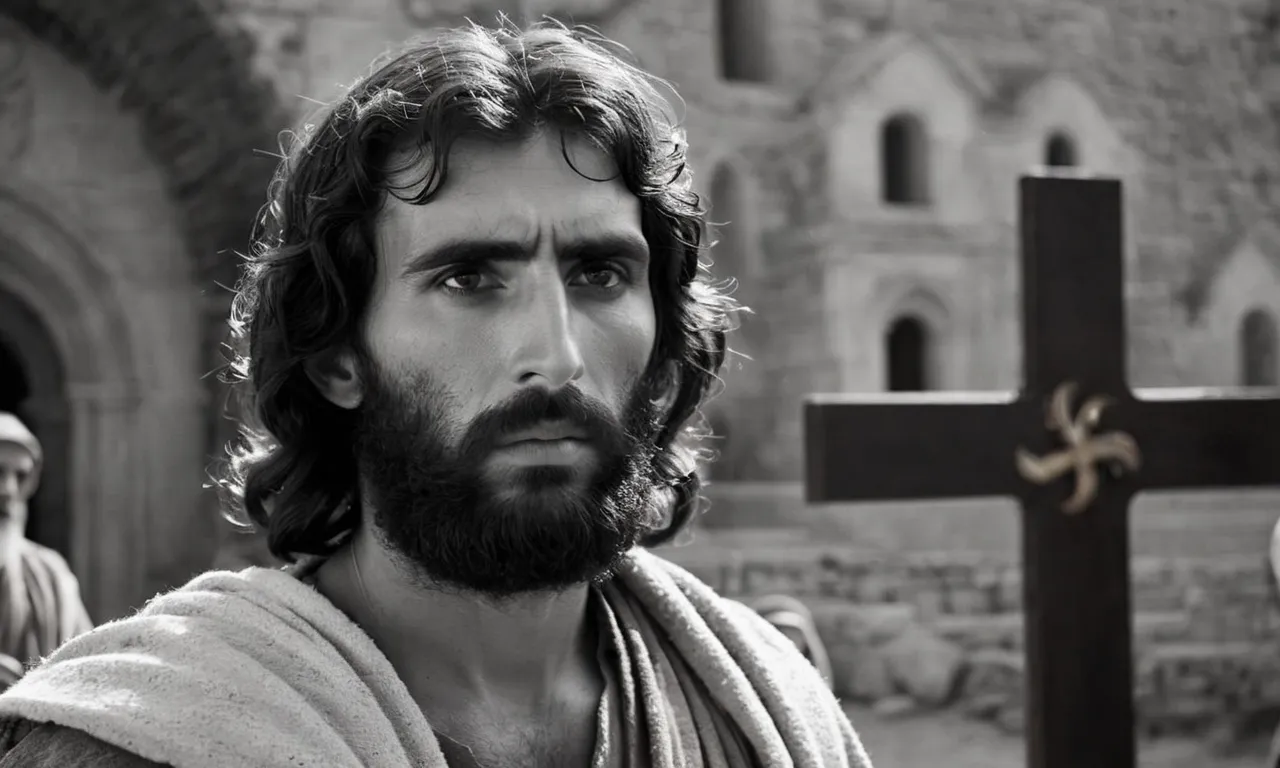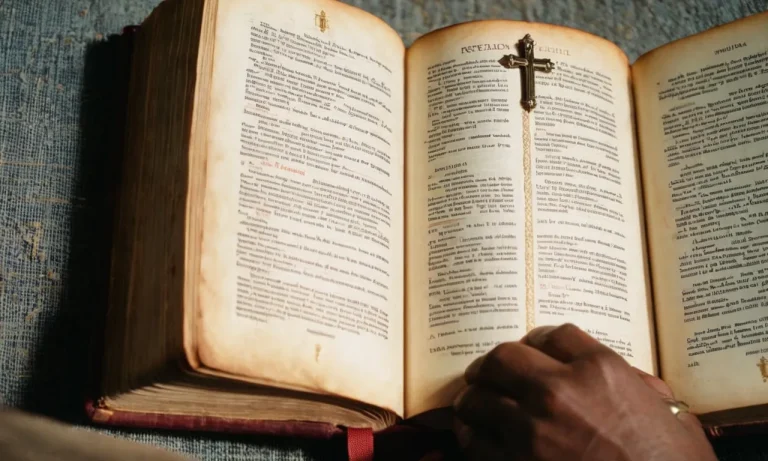Who Helped Jesus Carry The Cross?
The crucifixion of Jesus Christ is one of the most pivotal events in Christian theology. As Jesus carried the cross on which he would be crucified, the gospels record that he received some assistance along the way.
If you’re short on time, here’s a quick answer to your question: Simon of Cyrene was compelled by Roman soldiers to carry Jesus’ cross for him on the Via Dolorosa to Calvary.
In this approximately 3000 word article, we will examine in detail the biblical accounts of Jesus’ crucifixion and identify who helped him carry the cross on that sorrowful journey.
Jesus’ Condemnation by Pontius Pilate
Jesus Before Pilate
After being arrested, Jesus was brought before Pontius Pilate, the Roman governor of Judea, to be questioned and condemned (Mark 15:1-15). The Jewish religious leaders accused Jesus of claiming to be the King of the Jews and stirring up trouble, but Pilate did not find him guilty of any capital offense.
According to the Gospels, Pilate realized it was out of envy that the religious leaders had handed Jesus over (Matthew 27:18).
Pilate Sentences Jesus to Crucifixion
Though Pilate found him innocent, he feared the crowd’s rising furor and proposed to release Jesus as was customary during the Passover feast. But the crowd shouted for Jesus’ crucifixion. Wanting to satisfy the crowd, Pilate washed his hands before them, declaring he was innocent of Jesus’ blood, and handed Jesus over to be crucified (Matthew 27:24-26).
Jesus bore these injustices with dignity and without retaliation against his accusers or Pilate. Though innocent, he willing gave himself up for crucifixion, setting an example of sacrificial love and forgiveness.
Roman Practices of Crucifixion
Carrying the Crossbeam to the Crucifixion Site
In Roman crucifixion practices, the victim was typically required to carry their crossbeam (patibulum) from the place of condemnation to the crucifixion site outside of the city walls. According to historians, the horizontal crossbeam could weigh anywhere from 30 to 100 pounds – no easy load after being brutally flogged by flagrum.
Jesus initially began this arduous journey, carrying his rugged wooden crossbeam along the Via Dolorosa in Jerusalem, before Simon of Cyrene was compelled to take over.
The procession along the 1/3 mile Via Dolorosa (Latin for “Way of Grief”) was intended to not just exhaust and humiliate the condemned, but also serve as a gruesome warning against those who might threaten Roman authority.
Jeering crowds shouting mockery and abuse at the stumbling prisoners would line the path as they made their agonizing way to the crucifixion grounds.
The Via Dolorosa in Jerusalem
The Via Dolorosa was the traditional path Jesus and others condemned by Pontius Pilate had to traverse on their way to be crucified. This route is marked today by nine Stations of the Cross as an important Christian pilgrimage site.
According to the 19th station located on today’s Via Dolorosa, Jesus initially began carrying his cross from the Antonia Fortress. However, exhausted from the severe scourging and platting of thorns he had endured, Jesus stumbled under its tremendous weight (estimates range from 75 to 125 lbs).
Fearing he might die along the path and deprive them of the public crucifixion spectacle, the Roman guards randomly conscripted Simon, a Cyrene pilgrim, to carry Christ’s cross the rest of the 1/3 mile journey to Golgotha.
While the exact path of Christ’s Via Dolorosa walk is unclear, tradition holds Pilate ordered crucifixions to take place just outside his headquarters at the Antonia Fortress. This places the likely Crucifixion site at the Church of the Holy Sepulcher, one of Christianity’s holiest shrines.
Simon of Cyrene Helps Jesus
Simon Compelled to Carry the Cross
As Jesus carried his cross towards Calvary where he would be crucified, the gospels state that a man named Simon of Cyrene was compelled by Roman soldiers to help carry the cross (Matthew 27:32, Mark 15:21, Luke 23:26).
Simon had come into Jerusalem from Cyrene, a city in Northern Africa, and he was seemingly picked at random by the soldiers from the crowd that had gathered. Carrying the cross beam for a condemned criminal was an arduous task, but Simon helped ease Christ’s burden on the way to his death.
Simon’s Origins
The Bible provides some background on Simon’s origins, identifying him as being from Cyrene, an ancient Greek city located in modern-day Libya in Northern Africa (Matthew 27:32, Mark 15:21, Luke 23:26).
Jews from Cyrene had a synagogue in Jerusalem, so Simon may have been one of the diaspora Jews in town for the Passover feast (Acts 6:9). Beyond this, little else is known about Simon’s personal history or life outside of this act.
Later References to Simon
While Simon’s brief mention in the gospels ends once Christ is crucified, later Christian tradition provides some additional details. The second-century Church Father Irenaeus wrote that Simon was a farmer and father of two sons, Alexander and Rufus.
These two sons are also referenced in Mark’s gospel (Mark 15:21), suggesting they may have been known to the early Christian community in Rome where Mark was based. Other apocryphal texts claimed Simon later became a zealous convert and missionary of Christianity after witnessing Jesus’ passion firsthand.
While impossible to verify, these later legends indicate that Simon’s mercy and grace towards Jesus made a lasting impact during one of Christianity’s most pivotal moments.
Theological Significance of Simon’s Act
A Literal Assistance to Jesus
As Jesus struggled under the weight of the heavy wooden cross on the road to Calvary, the Roman soldiers commanded a passerby named Simon of Cyrene to carry it for him (Mark 15:21). This act provided literal, physical assistance to Jesus in his suffering.
Identification with Jesus’ Suffering
In being compelled to carry the cross with Jesus, Simon was uniquely able to identify with Christ’s suffering firsthand. As an innocent passerby, Simon vividly illustrates how all followers of Jesus are called to take up their crosses and identify with him (Matthew 16:24).
Interestingly, early church historian Eusebius records an oral tradition that Simon’s sons Rufus and Alexander became well-known Christians (Church History 3.32). Perhaps Simon’s profound experience walking with Jesus to Golgotha converted his whole household.
An Act of Service
While the Roman soldiers forced Simon to carry Jesus’ cross, he nevertheless performed an act of service that has inspired Christians for millennia. As Jesus said, “even the smallest act of service to another will be rewarded” (Matthew 10:42).
Simon’s simple act of carrying the cross with Jesus has become iconic of the Christian life of service and sacrifice.
According to tradition, Simon later became bishop of Jerusalem or bishop of Persia and was martyred for his Christian faith. If true, his life illustrates how even reluctant acts of service for Christ can transform into wholehearted devotion and discipleship.
Other People Who Assisted Jesus
The Women of Jerusalem
As Jesus carried the heavy wooden cross on his shoulders through the streets of Jerusalem, some of the women of Jerusalem wept for him. Though Jesus was in immense physical and emotional pain, he selflessly stopped to tell the women not to weep for him, but for themselves and their children (Luke 23:27-31).
This shows Jesus’ compassion even in his darkest hour. The women of Jerusalem recognized Jesus’ innocence and showed him empathy, even though most other onlookers shouted cruel insults at him.
Mary Magdalene, Mary Mother of James, and Salome
These courageous and devoted female followers of Christ watched the crucifixion from a distance (Mark 15:40). Despite the danger of being associated with Jesus, they refused to abandon him, even staying to witness his painful death. Their loyalty and love for Jesus is inspiring.
According to the gospels, Mary Magdalene and “the other Mary” later visited Jesus’ tomb to anoint his body, only to find it empty on resurrection morning (Matthew 28:1). Their steadfast faith even after Christ’s death is a model for all believers.
Joseph of Arimathea
Joseph of Arimathea was a wealthy and prominent member of the Jewish council who had secretly become a follower of Jesus (John 19:38). After Jesus died, Joseph courageously asked Pilate for Jesus’ body, providing him with a proper burial in a newly hewn tomb at great personal risk (Matthew 27:57-60).
Joseph did not abandon Jesus like most of the other disciples when things became difficult. His bold move to show honor to Christ even in death speaks volumes about his character. According to legend, Joseph was also one of the very first witnesses to the Resurrection, making him an important early church leader.
Conclusion
As we have seen, while Jesus bore the weight of the cross for our sins, he did not carry that heavy burden completely alone. Simon of Cyrene was compelled to physically lend a hand in carrying the crossbeam. Others, like the women of Jerusalem, provided comfort along the way.
Joseph of Arimathea gave his own tomb for Jesus’ burial. Their acts of service provide inspirational examples for Jesus’ modern-day followers.








